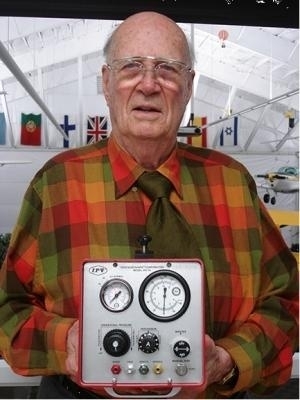 |
| Portrait of Forrest Bird (Aero News Network) |
With a name like his, Dr. Forrest M. Bird was destined to fly. He did so literally during his career as a WWII pilot, but he truly soared in his medical career. Dr. Bird created four generations of medical respirators meant to help those with respiratory issues around the world. I first learned about my personal career hero on Wikipedia; he is notable for the outstanding achievements he brought to his field. I look up to him because I take interest in biomedicine as well; I find the idea of helping people through science very appealing, just like Dr. Bird did.
The path to a career as a biomedical engineer is a long but rewarding one. One that wishes to enter the profession must usually acquire a bachelor's degree in biomedical engineering. On the job, biomedical engineers "analyze and design solutions to improve the quality and effectiveness of patient care." The work is difficult but worthwhile - according to The Bureau of Labor Statistics' Occupational Outlook Handbook, biomedical engineers made a median annual wage of $86,960 in 2012. Related occupations include chemical engineering and biochemistry. Recent developments in the field have brought us miracles like neural and tissue engineering, allowing those diagnosed with previously fatal diseases, like polio and emphysema, to live longer and healthier lives.
From an early age, Forrest Bird was encouraged to become a pilot by his father, himself a WW1 pilot. Bird starting flying solo at age 14; by the time he was 20 years old, he had enlisted in the Army Air Corps as a technical air training officer. It was here where he observed that pilots could not fly at altitudes above 28,000 feet due to lack of oxygen. This conundrum later became the inspiration for his most famous invention. After WWII, Bird attended multiple prestigious medical schools, and in 1955 he developed his first prototype respirator for cardiopulmonary care, the Bird Universal Medical Respirator. According to an interview published in the Winter 1995 edition of Sandpoint Magazine, Dr. Bird lives with his wife Pamela in Sandpoint, Idaho, where they manage Percussionaire Corporation, the manufacturing arm of Bird Space Technology. He still works on medical devices today, holding over 200 patents. They enjoy flying helicopters and fishing together.
Forrest Bird may not be a household name, but he is world-renowned in the medical world. He represents everything an aspiring researcher could want to be: intelligent, persevering, and visionary. His first wife, Mary Bird, made use of her husband's respirators before eventually succumbing to pulmonary emphysema in 1986. Despite this, Bird had successfully extended her life over 10 years, adding her to the long list of those helped by his work. Among Bird's greatest inventions is the "Baby Bird," a respirator for infants. It swiftly reduced infant mortality from respiratory issues worldwide from 70 percent to 10 percent. When asked by Sandpoint Magazine what the greatest part of his work was, he brought up a letter that he had received from a grateful mother whose daughter had suffered severe burns. The letter read "I've got my little daughter home now. She probably wouldn't be here if it hadn't been for your respirator." And she was right - before Bird, 80 percent of burn patients with lung damage died.
When I grow up, I want to follow in the footsteps of Dr. Bird. Most everything he did in life was passionate and rewarding. To succeed like him, I have set some very specific goals. I will take the highest mathematics and science classes in high school, including calculus and physics. These classes will help me get into great colleges, like John Hopkins or MIT. I will then earn a master's degree in biomedical engineering and find a position with on-the-job training. I would like to see the fruit of my effort in my life and change the world. One day, I hope to achieve and make global change on the same level as my personal career hero, Forrest Bird.
Page created on 5/30/2015 12:00:00 AM
Last edited 2/25/2019 6:23:26 PM
